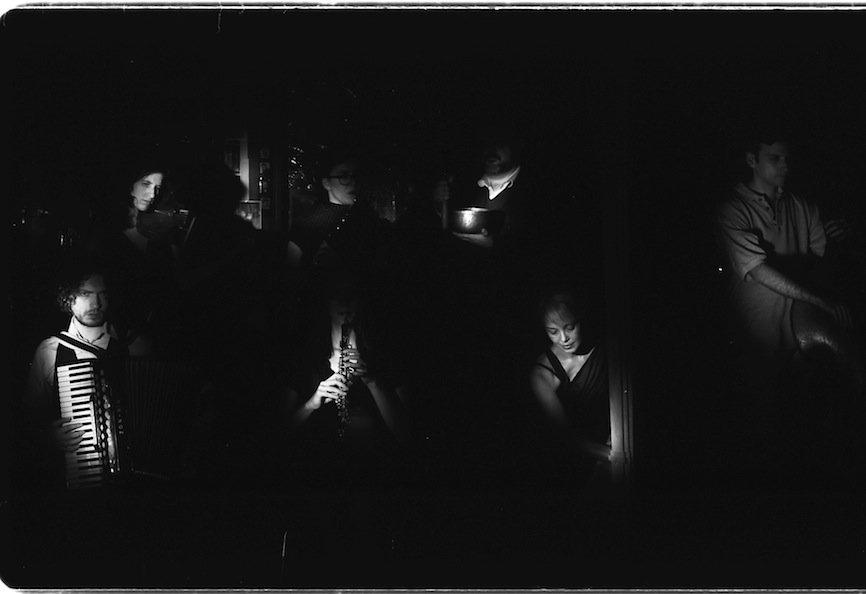Ghost Ensemble embodies the spirit of rugged independence
Classical music is, thankfully, past the struggles over post-World War II dogma that themselves were a musical reflection of the worst aspects of the 20th century. Contemporary classical music is in the midst of a fairly blissful epoch in which the overall value is inclusiveness and accessibility. Everything seems groovy.
But that doesn’t mean there aren’t differences or divisions in contemporary music making. There is a profound contrast between music that comes directly out of graduate and post-graduate programs and music that comes, metaphorically and literally, from the streets. Today’s it’s not an ideological battle, as much as coexistence among two equally essential sides of the same coin.
The academy has the advantage in resources and connections though, and new music that comes through the academy—often technically polished and conscious of its pedigree—is heard far more frequently than music the comes from independent musicians, composers and organizations.
That’s why the Ghost Ensemble’s concert Saturday night at the Secret Theater in Long Island City—day two of the third annual Queens New Music Festival, produced by the Random Access Music composers’ collective—was so welcome to the ears.
The ensemble is a composer/musician collective, putting on their own shows of original music and pieces they value. Core members are accordionist Ben Richter, flutist Martha Cargo, oboist Sky Macklay, harpist Somna M Bulist, violist Hannah Levinson, and percussionists Joe Tucker and Damon Loren Baker. For this concert, they are augmented by cellist Meaghan Burke and bass player James Ilgenfritz, with David Bloom conducting the full ensemble pieces with skill and musicality.
Ghost Ensemble is full of good musicians and they play with notable intensity. What makes them stand out is the bit of roughness amid the polish, The stimulating pleasure of the concert had a lot to do with quality and their independent attitude.
Richter and Macklay each had a composition on the program, and Richter’s undergraduate teacher, Kyle Gann, was in attendance for the world premiere of his Sang Plato’s Ghost, written for the ensemble.
Gann’s attractive score moves back and forth between an oblique minimalism—shifting chords and an angular, descending harp melody—and a graceful, amiable structure of melody and countermelody. Towards the end, it breaks into a dance in 5/4—Gann calls it a tango but it sounds more like a rumba with a mariachi line over the top. Debating the specific style is an indication of how interesting and enjoyable the music is.
Richter’s Star Maker shared a philosophy with the concert opener—Pauline Oliveros’ The Well and the Gentle—and the work that followed Richter’s, Giacinto Scelsi’s duo for cello and bass, Dharana (the latter given a gripping performance). All these pieces use sound to seek an altered consciousness, from a meditative awareness to a look, perhaps, into a different dimension.
The Well and the Gentle opened the night, and is one of Oliveros’ “Deep Listening” pieces: a structured improvisation that depends on the players following each other’s ideas, giving the mostly long tones the feeling of controlled drifting from one improvised chord to the next. The Secret Theater is a small, dry, black-box room, without the resonance that is a natural accompaniment to this music, and the nervous tension at that start of the concert meant a slightly faster pace than ideal. But the ensemble produced a consistent full sonority, and it was clear how avidly they were listening to each other.
Scelsi’s piece goes forcefully in the opposite direction, the cello and bass pressing sustained, tight dissonances against each other, trying to crack open the fabric of reality. One simple, and remarkably beautiful technique is the use of long, slow vibrato, the sound waves yawing across a space that sounds like an ego-destroying abyss.
Richter’s work fell in the middle of these sensibilities, waxing and waning in density and volume. He makes active use of electronics and complex sounds. There are two musicians who spend most of the piece rubbing stones slowly against pieces of concrete. The gesture is a striking connection to the music of Jürg Frey and the Wandelweiser school, but where that music is quiet, Star Marker is dense and weighty. With the stones, the music sounds like something incomprehensibly massive is passing by, slowly.
Different in style, but equal in quality, were works from Simon Steen-Andersen and Macklay. The latter, 60 Degree Mirrors, pushes complex sounds together—such as multiphonics in oboe and flute—and is more technical than spiritual. It’s no less satisfying, though, with a touch of Ligeti’s “clouds’ quality and a bit of creative unpredictability. Macklay uses disciplined means towards expressive ends.
Steen-Andersen’s Study for String Instruments #1 does one thing, and it does it fantastically well. The viola and cello play rising and falling glissandos, together in time, up and down the entire length of a string. There is no beat but there is a pace to the gestures, as one follows another with increasing frequency. The sound and sight of this elide in the uncanny sensation that one is seeing an oscillator’s amplitude and frequency modulate but with entirely different results.
Not a weak link in the bunch, and with the exception of Gann’s piece, not a moment of studied, advanced counterpoint, harmony, rhythm or standard structure. Just strong music, made with a singular spirit.
The Queens New Music Festival concludes today, with three concerts starting at 2 p.m. queensnewmusicfestival.org.



